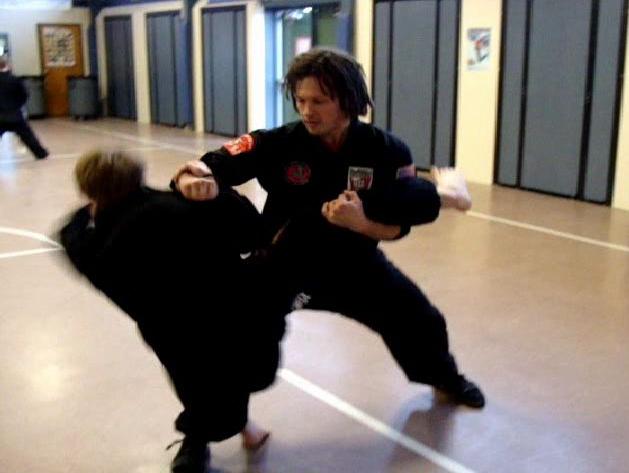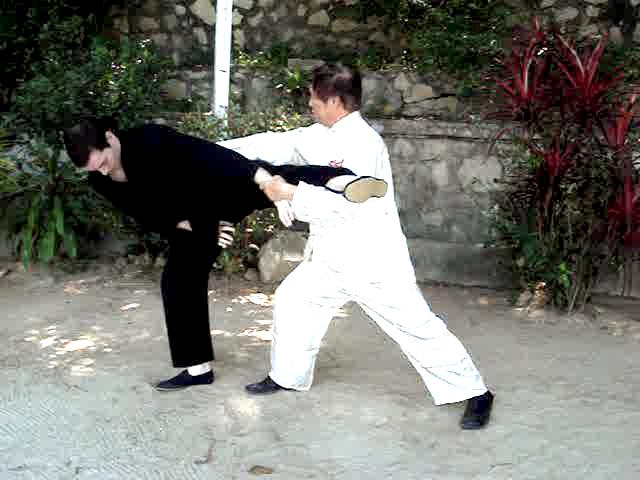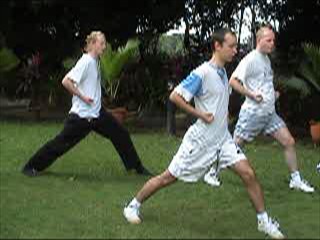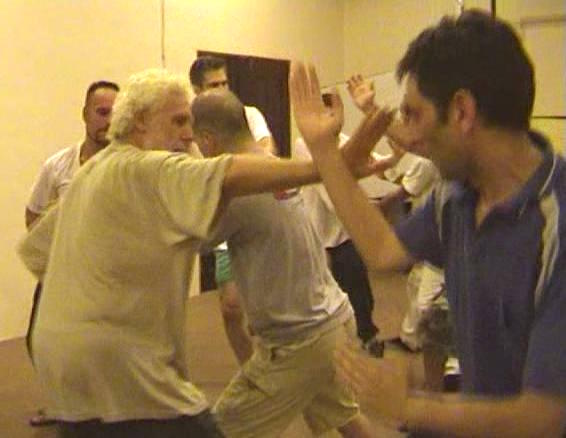April 2009 (Part 1)
SELECTION OF QUESTIONS AND ANSWERS

Matt Fenton demonstrates a felling technique, applied in the pattern “Plant Willow in Front of Camp”, hidden in Eagle Claw Combat Sequence 2. Click here to view a video clip of the combat application.
Question 1
I have recently seen several different forum topics that have resulted in challenges being issued by my Shaolin Wahnam seniors as well as challenges being accepted by my seniors. I understand the reason, as all challenges I have seen have been a direct result of visitors to the forum directly insulting you and your teachings.
— Matt, USA
Answer
In particular the latest of the challenges you mentioned is in the Eagle Claw Master thread of our discussion forum. I have followed the thread closely and am very impressed with your observation that there are felling techniques hidden in Eagle Claw Sequence 2. Your observation confirms my belief that you and James probably know more of Eagle Claw combat than many Eagle Claw practitioners.
As I have also stated, this is no slight on Eagle Claw practitioners because the norm today is that most kungfu practitioners of any style only perform kungfu forms and have little or no experience of combat application. This is a main reason why kungfu today has been debased to such a pathetic level where even some masters fight like children or at best use Kick-Boxing when sparring with exponents of other martial systems.
I am pleasantly surprised that you could see in Sequence 2 hidden felling techniques. Not many kungfu exponents, including Eagle Claw practitioners, could see this. As I have not included felling techniques in the video clips I have prepared for Sequence 2, it will be very beneficial to our Shaolin Wahnam students as well as forum guests if you can describe them. This will also encourage them to take a more active part in the discussion on Eagle Claw application.
Question 2
Yet, I am reminded of the story you told in “The Complete Book of Shaolin”, of Sigung talking you out of a challenge. A passage that sticks out for me is, “Then the question of defending your honor does not arise. As the accusation is false, there is no need for you to defend.”
I know you oversee the discussion forum and approve of the actions of the seniors. I am just confused. I, too, feel a strong desire to defend my Sifu when visitors directly toss insults, but it is due to the words in your book that I am reminded that these insults are hollow because they are based on false ideas and not the truth.
Answer
It is indeed a pity that instead of benefiting from our video presentation and be grateful for it, WongYing chose to attack and insult us.
Our position is very clear. We have great respect for Eagle Claw Kungfu. That is why we intend to have a special course on Eagle Claw at the UK Summer Camp this year so that our students as well as instructors have exposure to this great art. If WongYing or anybody interprets this as an insult to Eagle Claw practitioners, which was never intended to be in the first place, that is his problem, not ours.
Despite his having 26 years of Eagle Claw training, it is obvious to us that WongYing knows little, or nothing, about Eagle Claw combat application. He also knows little about Eagle Claw philosophy and could not answer your very appropriate and reasonable question as to why, according to his understanding, Sequence 1 is important in Eagle Claw Kungfu. Sadly, WongYing's case is typical of many kungfu practitioners today.
I do not like to use the word “stupid”, but it aptly describes WongYing's action in publicly calling my performance of Eagle Claw Sequences 1 and 2 “fa khuen sau thui”, which means “flowery fists and embroidery kicks” in Cantonese. In kungfu culture it is the worst of insults.
It is unthinkable for anyone to use it on a grandmaster of a school because it is issuing a challenge to the whole school. Personally, if someone calls my kungfu “fa khuen sau thui”, I would be amused, but when it applies to our whole school it becomes a serious matter. It is no surprise that so many of our instructors and students rise to the occasion and accept WongYing's challenge.
Our position on challenges is also very clear. We do not challenge others but if others challenge us, we take it seriously. We study the challenger and his challenge carefully and respond accordingly. So far, we have accepted every one of the challenges our distractors throw at us, and we are glad that without a single exception every challenger withdrew his challenge.
Mahmood issuing a challenge to Sanda Warrior, whom Mahmood rightly calls a Keyboard Warrior, is an exception, which we approve. Mahmood's action is due to his sense of righteousness and loyalty to our school. Not many people know that Mahmood was already a national Taekwondo champion before he learned from me, and since learning from me his combat efficiency has improved remarkably. I believe Mahmood would easily beat a keyboard warrior who dared not even give his real name.

Here is another felling technique, applied in the pattern “White Monkey Catches Pig”, hidden in Eagle Claw Combat Sequence 2 demonstrated by Max Fenton and Patrick. Click here to view a video clip of the combat application.
Question 3
In the story of Sigung and your challenge match, the insult was directed at you, and you took up the challenge. Is the situation different for my seniors, as the insult was directed at you, their Sifu, and not at them directly?
Answer
As in many other issues in life, the answer can be “yes” or “no” depending on different perspectives.
From one perspective, the two situations were different. In the first situation, others insulted me and indirectly my school, I rose to the occasion to defend my school. In the present situation, WongYing insulted me, and also our school. My students and grand-students, not I myself, rise to defend me and our school.
From another perspective, both situations are the same. In both cases, it is not just a personal insult, but an insult to the whole school, and disciples of the school rise to the defence.
Question 4
In your story, Sigung said that if an action brings harm to others and not ourselves, we will not do it. And then points out that the challenge match will bring harm to both sides.
When looked at from this perspective, a challenge does seem like a very trivial action to take. Yet, to sit idly by while a visitor insults my Sifu... that is very hard to do. Sifu, could you please offer me some insight to the issue of insults and challenge matches?
Answer
We are trained to be scholar-warriors. As scholar-warriors we do not rashly issue or accept challenges. We study each case carefully and only when we are very sure of winning, do we accept a challenge, or issue one in an exceptional situation. A scholar-warrior does not fight and then hopes to win. He already has won, the fighting is just to confirm his victory.
Our acceptance of challenges as well as Mahmood's issuing a challenge is in line with my Sifu's teaching of doing good. “Good” is whatever that brings benefit to ourselves and to others, and “evil” is whatever that brings harm.
In the case of WongYing, for example, not accepting his challenge will bring harm because many people, including some of our own students, may wrongly perceive that like many kungfu schools today we merely talk and are unable to put our words in action. This will seriously hamper our effort in restoring the greatness of genuine kungfu as a martial art.
By accepting his challenge, we walk our talk as we have always done and will always do. This will contribute to our effort in preserving genuine kungfu not only as an effective martial art but also as a training of courage and wisdom.
We do not glamorize fighting, but if we have to fight, not only we will fight well but also ensure we will definitely win. We have more than sufficient resources to do so. You would have noticed that as soon as we give a signal to accept a challenge, at once a dozen Shaolin Wahnam scholar-warriors volunteer to defend our school.
If we make a call-up, we should have no difficulty getting 50 Shaolin Wahnam scholar-warriors world-wide to meet the challenger. We are very proud of our scholar-warriors who are ever ready to defend our school.
If we arrange to have a match with a challenger once a week, we have enough fighters to keep him busy for a whole year. But we won't be busy for a year. As scholar-warriors we won't fight unless we are sure of winning. Hence, we are confident of beating the challenger convincingly in the very first encounter.

Grandmaster Wong applies the pattern “White Monkey Catches Pig” to trap Sifu Jamie's kick in a combat application of Eagle Claw Combat Sequence 2.
Question 5
It is very humbling to know a world-renowned Shaolin Grandmaster will give you an answer when you call him Sifu. It makes smiling from the heart a very easy thing to do!
Answer
With this background, you can readily derive answers for your questions. But to be more specific, if you wish to accept WongYing's challenge, you are justified in doing so.
Please note that it is not you issuing a challenge, you are just righteously responding to his challenge. He challenged us when he called the kungfu of the grandmaster of the school “flowery fists embroidery kicks”. You, like many others, are rising to the occasion to prove him wrong in action.
I am also very confident that you can beat WongYing easily, otherwise I would not approve of your accepting his challenge. It will be interesting to see how a “complete novice”, as WongYing arrogantly called you despite your having shown deep understanding of kungfu combat, beat someone who has 26 years of kungfu training.
How can I know WongYing's level of combat efficiency when I have not met him in person? I can easily and correctly access him from what and how he has written in our forum. If I can't do that, I can't be a grandmaster of Shaolin Kungfu.
Those who have expressed their acceptance of WongYing's challenge, and who also have my approval, can also access WongYing's level and they are also confident of beating him. Otherwise they can't be scholar-warriors and I won't approve them of their accepting the challenge.
Question 6
Do you have any videos for wheelchair patients? I am not in a wheelchair but I cannot do standing exercise. I walk with a walker and am in a lot of pain.
— Gen, Australia
Answer
What you need is not some videos to entertain you when you are on a wheelchair, but a determined vision to throw away your walker and function as a normal person.
Please be clear that a vision is very different from a fancy. It is of course not enough just to fantasize that you will be walking normally without pain, but have a realistic vision that this can happen, and have determination to work towards this vision.
You would be inspired to know that I have helped many people throw away their walkers and wheelchairs, and start walking normally again. The following webpage From Sitting on a Wheelchair to Walking in a Street is a recent example.
Ideally I would recommend that you apply to attend my Personalized Chi Kung Course, where I shall teach you alone and specifically how to overcome your health problem. Honestly I regard this as my duty to help sincere people who ask for my help. Personally I would prefer you to attain my Intensive Chi Kung Course where you will join other people to learn chi kung in general, but if you continue to practice on your own you can overcome your health problem.
If you are interested, please apply to my Secretary at secretary@shaolin.org. Or you may learn from our certified chi kung instructors or healers. Please see http://www.shaolin.org/general/instructors-list.html.
Please note that while we are confident you will overcome your health problem, we cannot guarantee that you will certainly be cured.

The Bow-Arrow Stance performed in our school is quite different from that in many other schools. The feet in our Bow-Arrow Stance are in line, and the front knee does not protrude beyond the front ankle, forming a pyramid shape.
Question 7
Do you know why some Wudang Tai Chi forms practice slanting forward postures? I had wondered about the protection of the knees and was pleased by one of your answers to the risk of slanting too far forward.
— Stephanie, USA
Answer
Not only in Wudang Tai Chi Chuan, but also in all other styles of kungfu, one should not slant too far forward in his stances. The bent knee should not go beyond the ankle of that leg.
Irrespective of the stance he is in, like Bow-Arrow, Horse-Riding or False-Leg, if one constantly has his posture slanting too far forward, he would cause knee injury. His agility is also affected. If an opponent attacks him, it would be slower for him to react.
Nevertheless, in Wudang Tai Chi Chuan as well as in other kungfu styles, in some ad-hoc situations, like when you wish to add reach or to control an opponent's leg, you may slant your posture more forward than usual.
However, many wushu practitioners today adopt deep stances where their knee protude far beyond their ankle. They probably do so for aesthetic purposes, but it is bad for health. It is no surprise therefore that many wushu athletes suffer from arthritis and knee injuries.
Question 8
I have been reading your book, “The Art of Shaolin Kungfu”, and have enjoyed studying it. I am very interested to know if you have a master who studied under you in my area. I have wanted to study Shaolin Kung Fu for over 35 years now. I would be starting from scratch. I would be most appreciative and honored with your suggestions.
— Bob, USA
Answer
We don't have a certified instructor in your area at present. We have a few certified instructors in USA. Please see our List of Certified Instructors page for details.
The type of Shaolin Kungfu taught today is very different from what I describe in my book, “The Art of Shaolin Kungfu”. For example, most Shaolin schools today focus on external training. There is little or no internal force taught. These schools also do not apply Shaolin patterns for combat. They usually use other martial art techniques, especially Kick-Boxing, for sparring.
In contrast, we in Shaolin Wahnam emphasize internal force and apply Shaolin patterns for combat. We also pay much attention to spiritual, but not religious, cultivation as well as applying the principles and skills we learn in our kungfu class to our daily living.
If you are passionate about learning Shaolin Kungfu as described in my book, you may contact our instructors to see if some special arrangement can be made if you decide to learn from then. They are very good instructors.
Alternatively, you may learn from a Shaolin or wushu school in your area, even though this school may not teach internal force or use Shaolin patterns for combat. The main objective is to learn correct kungfu forms from this school. When you can perform Shaolin forms reasonably well, you can attend my Intensive Shaolin Kungfu Course to learn how to develop internal force and apply Shaolin patterns in sparring. A few have followed this procedure successfully.
I would advice that you spend some time choosing a good kungfu or wushu school in your area to learn the kungfu forms even if you may be unable to learn internal force and Shaolin combat application from this school. The teacher should be an honorable person with high morality. This is very important.
If you intend to learn from me or any of our instructors later, I would recommend that you choose a school that does not teach free sparring. This may sound odd because we in Shaolin Wahnam consider combat application an essential aspect of kungfu training. Nevertheless, in our opinion, free sparring is badly taught in most kungfu schools today where the students are routinely hurt. They do not systematically learn how to defend themselves; they just go in to hit and kick their sparring partners. This is not only damaging to their body, but also to their psyche.
Despite much time spent in free sparring, they do not know how to defend themselves. In other words, they may be good at hitting and kicking others, but they themselves, even at fairly advanced levels in their schools, would be hit and kicked too. They commit a serious mistake known in kungfu saying as “mei hok fong sun, seen seong sun” (Cantonese pronunciation), which means “before learning how to defend themselves, they have already hurt themselves.”
This is against fundamental kungfu philosophy, which believes in the saying “mei hok fong sun, seen keong sun”, which means “before learning combat application, you should first strengthen yourself.” Hence, at the initial stage of training in our school we pay much attention to stance training and energy flow, which will strengthen the students physically and spiritually. Then our students systematically learn how to apply Shaolin patterns for combat, as well as Shaolin skills and principles to enrich their daily life.

In our school we use typical kungfu forms, and not Kick-Boxing, in our sparring. This rare photo captures some free sparring amongst masters of our school. In the foreground Sifu Riccardo Salvatore of Portugal uses Shaolin Kungfu in his free sparring against Sifu Javier Galve of Spain using Taijiquan.
LINKS
Selected Reading
- Cultural Meanings of Sifu Wong Chun Nga's Wedding Ceremonies
- The Shaolin Wahnam International Show
- The Aims and Objectives of Practicing Kungfu
- My Chi Kung Experience
- The Blessing and Responsibility of Being a Husband and Father
